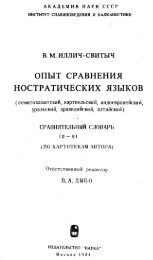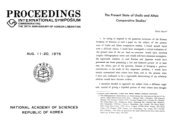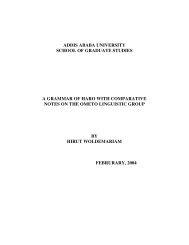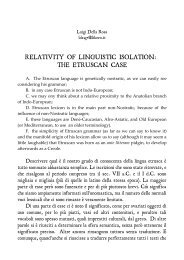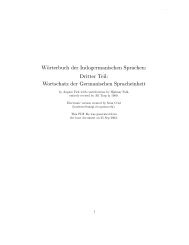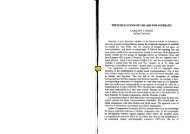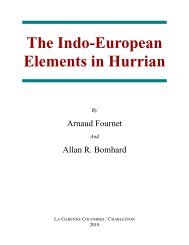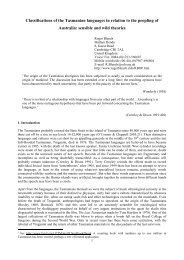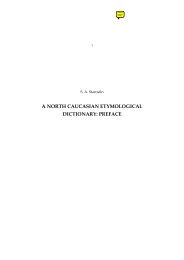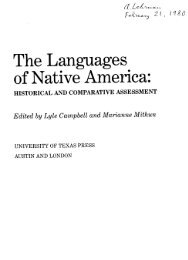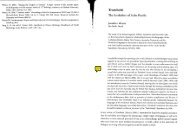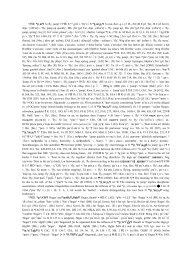Create successful ePaper yourself
Turn your PDF publications into a flip-book with our unique Google optimized e-Paper software.
Balto-Fennic Loanwords<br />
in Early North <strong>Germ</strong>anic 70<br />
ADAM HYLLESTED<br />
University of Copenhagen<br />
1 Early Scandinavian-Fennic Contacts<br />
In recent years, archaeologists and runologists have made remarkable<br />
discoveries about the early activities of Eastern Scandinavians on their<br />
trade routes to the Caspian Sea and the Black Sea. In the Merovingian<br />
period (500-800 AD, the time preceding the Viking Age), these routes<br />
cut through vast areas with Fennic-speaking populations, and Poussa<br />
(2004) has put forward the hypothesis that the reduction of phoneme<br />
symbols in the Younger Futhark from 24 to 16 was due to external influence<br />
by an early Balto-Fennic language, seeing that the reduced Runic<br />
consonant inventory resemble those of the Balto-Fennic languages.<br />
In an area characterized by lively trade and intensive contact between<br />
the speakers of two divergent linguistic groups, we would expect<br />
to find a lot of obviously borrowed lexical material. However, only a<br />
single article on Balto-Fennic <strong>loan</strong>words in North <strong>Germ</strong>anic has been<br />
published recently (Hofstra 1997) and hasn’t added more than a single<br />
word to the already scarce material, namely ON jalda ‘mare’ from a hypothetical<br />
PBF *ältä, gen. *älδän, corresponding to Mordvin äld’ä (Hofstra<br />
1997: 129)<br />
Bergsland (1965) demonstrated that the Nordic name of the ‘fox’, ON<br />
refr, having cognates as far away as in Ibero-Romance, must be a<br />
70 This short sketch is based on a lecture (“Balto-Fennic Influence on Early North<br />
<strong>Germ</strong>anic”) given at the interdisciplinary symposium The Futhark and the Fur<br />
Trade at the University of Umeå, September 2005. A more thorough version will<br />
be printed in Patricia Poussa and Per Ambrosiani (eds.): The Futhark and the<br />
Fur Trade: Language Contact in the Pre-Viking Period (Umeå: Kungliga Skytteanska<br />
Samfunnets Handlingar).
62<br />
ADAM HYLLESTED<br />
Scythian/Alanian <strong>loan</strong>word in Balto-Fennic (e.g. Fi. repo; see also Brøndal<br />
1928, Hofstra 1997: 129) from where it was borrowed into Nordic.<br />
The rest is ON sylgja ‘brooch’ < PBF *solki ‘buckle’ (de Vries 1962,<br />
Hofstra 1997 : 130-132), ON peyta ‘fur’, cf. Fi. paita (de Vries 1962,<br />
Hofstra 1997 : 127-128), ON sóta ‘war’, cf. Fi. sota (de Vries 1962, Hofstra<br />
1997 : 128), seið ‘witchcraft’, cf. Fi. seita (Parpola 2004).<br />
1 New etymologies<br />
1.1 OLD NORSE ‘WILLOW’ PÍLL<br />
ON píll m. ‘willow’ (earlier also ‘poplar’) is usually interpreted as a derivation<br />
of píla f. ‘arrow’, either referring to the shape of the leaves or to<br />
the use of willow wood for bow-making.<br />
There are good reasons to dismiss this etymology. First of all, willow<br />
wood is in fact not very apit for producing bows or arrows. Second, A<br />
popular designation for the rowan in <strong>Germ</strong>an is Pielbeerbaum (not<br />
†Pfeilbeerbaum), officially called Vogelbeerbaum, Eberesche, whose initial<br />
non-affricated p- shows that it must be borrowed from Nordic or<br />
Low <strong>Germ</strong>an. Finally, the very fact that there are several explanations of<br />
how the tree got its name is suggestive of a folk etymology.<br />
I propose the following alternative etymology: ON píll goes back to<br />
Early North <strong>Germ</strong>anic *pihlar, a <strong>loan</strong>word from Balto-Fennic *pihla-<br />
‘rowan’, cf. Est. pihl, pihlakas, Fi. pihlaja, pihlava. It cannot a be a <strong>loan</strong>word<br />
in the reverse direction since the Balto-Fennic word has a wellestablished<br />
Fenno-Ugric etymology, going back to PFU *pićla ‘id.’<br />
(UEW 729, Campbell 1990: 168), and there are numerous cognates in<br />
other Fenno-Ugric languages: Cheremis (Mari) pizle, Votyak (Udmurt)<br />
paleź, Vogul (Mansi) paśar. Another PFU root which is probably ultimately<br />
related *pećɛ (without the suffix -la) has the meaning ‘willow’ (><br />
Hung. füz, Zyrian/Komi paća ‘id.’ and Votyak puč’i ‘bud, willow chadkin’;<br />
UEW 367).<br />
Extralinguistic facts about these trees provide a clear motivation for<br />
borrowing: the rowan was believed to possess a magic force and is thus<br />
a typical culture-word. Rowan wood is quite suitable for engraving<br />
signs, which might have paved the way for its religious importance. Willow<br />
leaves and and rowan leaves are of quite similar shape, and they<br />
both have a greyish underneath. The name might have been specifically<br />
applied to the rowan species Sorbus intermedia whose generic name
Balto-Fennic Loanwords in Early North <strong>Germ</strong>anic 63<br />
indicates the similarity with willows just like the Danish name seljerøn<br />
(lit. ‘willow rowan’).<br />
1.2 OLD NORSE HARKI ‘(FISH) RAKE’<br />
According to the standard handbooks (e.g. de Vries 1962), ON harki<br />
‘(fish) rake’ is cognate of harka ‘clatter; hark’ and skrapa ‘scrape,<br />
scratch’, ultimately derived from PIE *(s)ker- ‘cut etc.’.<br />
MLG harke is borrowed from Nordic, which makes the word exclusively<br />
North <strong>Germ</strong>anic. The extremely specialized shared with Proto-<br />
Balto-Fennic *harkka or *haraka (Fi. harkki, Est. haro < *haraγ-) ‘(fish)<br />
rake, harrow’ makes it very likely that the <strong>Germ</strong>anic word is borrowed<br />
Balto-Fennic and has nothing to do with the PIE root for ‘to cut’. It<br />
cannot be a borrowing the other way round since the Balto-Fennic word<br />
is known to be derived regularly < FU *šara-ka, a derivative of the same<br />
root *šara as the next item. As a tool term, it constitutes a typical <strong>loan</strong>word.<br />
1.3 OLD NORSE HERFI ‘HARROW’<br />
ON herfi ‘harrow’ (< pre-umlaut *harfi), traditionally accepted as a<br />
cognate of harvest (< P<strong>Germ</strong>. *harbista-), likewise from IE *(s)ker- ‘cut<br />
etc.’.<br />
Middle English harewe is borrowed from Nordic, which makes this<br />
word exclusively North <strong>Germ</strong>anic as well, whereas its alleged cognate<br />
‘harvest’ is widespread in West <strong>Germ</strong>anic. Striking formal and semantic<br />
similarity with the Balto-Fennic word which is known to be old and<br />
cannot have been borrowed from Nordic.<br />
Again, striking formal and semantic similarity between this word<br />
and Proto-Balto-Fennic *harava ‘harrow’ (< Fenno-Ugric *šara-pa), a<br />
derivative of the same root *šara as the previous item, renders a Balto-<br />
Fennic origin more than probable. Again, the word designates a specialized<br />
tool. Due to the vocalism in herfi, the borrowing must have<br />
taken place before the rise of the Nordic i-umlaut. Like in the case of<br />
píll, this speaks for the Merovingian period 500-800 B.C.
64<br />
ADAM HYLLESTED<br />
1.3 OLD NORSE HAMARR ‘HAMMER; STONE’ AND GERMANIC<br />
COGNATES<br />
ON hamarr ‘hammer; stone’, even though it is a common <strong>Germ</strong>anic lexeme,<br />
will also be treated here because of its obvious semantic and formal<br />
similarities to harki and herfi. It is generally supposed to be related<br />
to Slavic kamy ‘stone’ and by some scholars even to himinn ‘heaven’ (<<br />
‘vault’), cf. that both meanings are covered by related words in Sanskrit<br />
and Iranian.<br />
Fi. hamara ‘back of an axe’ is usually regarded as a borrowing from<br />
<strong>Germ</strong>anic ; the h- in this word, however, regularly goes back to PFU *š-<br />
as in harkki and harava: the Fenno-Volgaic proto-form is *šama-ra, cf.<br />
North Saami šibmar ‘pole of axe’, Lule Saami sjimēr ‘back of a hammer’<br />
Skolt Saami šammer ‘hatchet’, Mordvin čov, šov ‘back of a knife’ (UEW<br />
782-783). Unless we are dealing with a remarkable coincidence, it seems<br />
that the <strong>Germ</strong>anic word for ‘hammer’ is not at all Indo-European, but in<br />
fact borrowed from Fennic. It thus seems that terms for tools have been<br />
borrowed from Balto-Fennic languages not only into the Merovingian<br />
period, but even earlier, at least in a common West <strong>Germ</strong>anic period.<br />
Theoretically, it is possible that the <strong>Germ</strong>anic tool term has been<br />
contaminated with the very similar Fenno-Ugric one, so that we are in<br />
fact dealing with a word of multiple origins. It is important to note,<br />
though, that the IE item is somewhat irregular and that the <strong>Germ</strong>anic<br />
word is semantically closer to the Fenno-Ugric one than to its alleged IE<br />
cognates.<br />
References<br />
Bergsland, Knut, 1965: “<strong>Finn</strong>o-Scandinavian rebas ‘fox’”. – Norsk Tidsskrift for<br />
Språkvitenskap 20: 243-248.<br />
Brøndal, Viggo, 1928: “Mots “scythes” en nordique primitif”. – Acta Philologica<br />
Scandinavica 3: 1-31.<br />
Campbell, Lyle, 1990: “Indo-European and Uralic Tree Names”. – Diachronica 7:<br />
149-180.<br />
Hofstra, Tette, 1997: “Zu mutmaßlichen frühen ostseefinnischen Lehnwörtern im<br />
Nordgermanischen”. – S.-L. Hahmo, T. Hofstra, L. Honti, P. van Linde & O.<br />
Nikkilä (eds.): <strong>Finn</strong>isch-ugrische Sprachen in Kontakt. Maastricht: 127-134.<br />
Jansson, Ingmar, 2003: “Kulturkontakter och kontinuitetsbroot i Östersjöområdet -<br />
ur en arkeologs perspektiv”. – Staffan Nyström (red.) Namn och kulturella kontakter<br />
i Östersjöområdet [= Norna-rapporter 78]. Uppsala: Norna-Förlaget. 11-<br />
59.
Balto-Fennic Loanwords in Early North <strong>Germ</strong>anic 65<br />
Parpola, Asko, 2004: “Old Norse seiðr, <strong>Finn</strong>ish seita and Saami shamanism”. – I.<br />
Hyvärinen, P. Kallio, and J. Korhonen (eds.), Etymologie, Entlehnungen und<br />
Entwicklungen: Festschrift für Jorma Koivulehto zum 70. Geburtstag [=<br />
Mémoires de la Société Néophilologique de Helsinki 63]. Helsinki. 235-273.<br />
Poussa, Patricia, 2004 : “The futhark and the fur trade : on the adaptation of an<br />
alphabet by its users”. – Fred Karlsson (ed.) : Proceedings of the 20th<br />
Scandinavian Conference of Linguistics [= University of Helsinki, Department of<br />
Linguistics, Publications no. 36].<br />
UEW = Károly Rédei 1988: Uralisches Etymologisches Wörterbuch I-III. Budapest :<br />
Akadémiai Kiadó.<br />
de Vries, Jan, 1962: Altnordisches Etymologisches Wörterbuch. Leiden: Brill.



